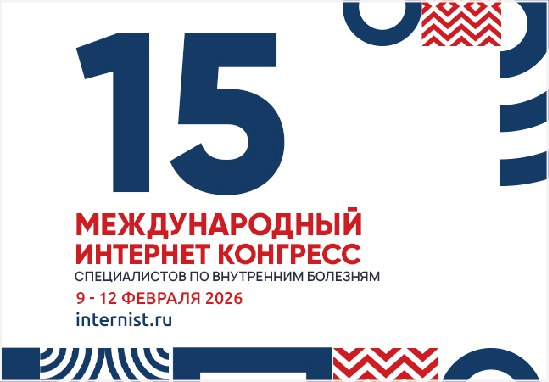Антигипертензивная терапия и развитие новых случаев сахарного диабета. Можно ли снизить риск?
Аннотация
Список литературы
1. Gress TW, Nieto FJ, Shahar E, et al. Hypertension and antihypertensive therapy as risk factors for type 2 diabetes mellitus. Atherosclerosis Risk in Communities Study. N Engl J Med 2000; 342(13): 905-12.
2. Mykkenen L, Kuusisto J, Pyereli K, et al. Increased risk of non-insulin-dependent diabetes mellitus in elderly hypertensive subjects. J Hypertens 1994; 12(12): 1425-32.
3. Isomaa B, Almgren P, Tuomi T, et al. Cardiovascular morbidity and mortality associated with the metabolic syndrome. Diabetes Care 2001; 24(4): 683-9.
4. Sharma AM. Is there a rationale for angiotensin blockade in the management of obesity Hypertension? Hypertension 2004; 44(1): 12-9.
5. Greenfield JR, Campbell LV. Role of the autonomic nervous system and neuropeptides in the development of obesity in humans: targets for therapy? Curr Pharm Des 2008; 14(18): 1815-20.
6. Rahmouni K, Correia MLG, Haynes WG, Mark AL. Obesity-associated Hypertension. New insights into mechanisms. Hypertension 2005; 45(1): 9-14.
7. Lau DC, Dhillon B, Yan H, et al. Adipokines: Molecular links between obesity and atherosclerosis. Am J Physiol Heart Circ Physiol 2005; 288: H2031-41.
8. Sowers JR, Bakris GL. Antihypertensive therapy and the risk of type 2 diabetes mellitus. N Engl J Med 2000; 342(13): 969-70.
9. Taylor EN, Hu FB, Curhan GC. Antihypertensive Medications and the Risk of Incident Type 2 Diabetes. Diabetes Care 2006; 29(5): 1065-70.
10. Bangalore S, Parkar S, Grossman E, Messerli FH. A metaanalysis of 94492 patients with hypertension treated with beta blockers to determine the risk of new-onset diabetes mellitus. Am J Cardiol 2007; 100(8): 1254-62.
11. ALLHAT Collaborative Research Group. Majoroutcomesinhighrisk hypertensive patients randomized to angiotensinconverting enzyme inhibitor or calcium channel blocker vs diuretic: the Antihypertensive and Lipid-Lowering Treatment to Prevent Heart Attack Trial (ALLHAT). J Am Med Assoc 2002; 288(23): 2981-97.
12. Dahlof B, Sever PS, Poulter NR, et al. ASCOT Investigators. Prevention of cardiovascular events with an antihypertensive regimen of amlodipine adding perindopril as required versus atenolol adding bendroflumethiazide as required, in the Anglo-Scandinavian Cardiac Outcomes Trial-Blood Pressure Lowering Arm (ASCOT-BPLA): a multicentre randomised controlled trial. Lancet 2005; 366(9489): 895-906.
13. Braunwald E, Domanski MJ, Fowler SE, et al. PEACE Trial Investigators Angiotensin-converting-enzyme inhibition in stable coronary artery disease N Engl J Med 2004; 351(20): 2058-68.
14. Yusuf S, Gerstein H, Hoogwerf B, et al. Ramipril and the development of diabetes. J Am Med Assoc 2001; 286(18): 1882-5.
15. Pepine CJ, Handberg EM, Cooper-DeHoff RM, et al. A calcium antagonist vs a non-calcium antagonist hypertension treatment strategy for patients with coronary artery disease. The International Verapamil-Trandolapril Study (INVEST): a randomized controlled trial. J Am Med Assoc 2003; 290(22): 2805-16.
16. Lindholm LH, Ibsen H, Borch-Johnsen K, et al. For the LIFE study group. Risk of new-onset diabetes in the Losartan Intervention For Endpoint reduction in hypertension study. J Hypertens 2002; 20(9): 1879-86.
17. Okin PM, Devereux RB, Harris KE, et al. LIFEStudy Investigators. In-treatment resolution or absence of electrocardiographic left ventricular hypertrophy is associated with decreased incidence of new-onset diabetes mellitus in hypertensive patients: the Losartan Intervention for Endpoint Reduction in Hypertension (LIFE) Study. Hypertension 2007; 50(5): 984-90.
18. Lithell H, Hansson L, Skoog I, et al. The Study on Cognition and Prognosis in the Elderly (SCOPE): principal results of a randomized double-blind intervention trial. J Hypertens 2003; 21(5): 875-86.
19. Julius S, Kjeldsen SE, Weber M, et al., for the VALUE trial group Outcomes in hypertensive patients at high cardiovascular risk treated with regimens based on valsartan or amlodipine: the VALUE randomised trial. Lancet 2004; 363: 9426: 2022-31.
20. Kjeldsen SE, McInnes GT, Mancia G, et al. Progressive effects of valsartan compared with amlodipine in prevention of diabetes according to categories of diabetogenic risk in hypertensive patients: The VALUE trial. Blood Press 2008; 17(3): 170-7.
21. Weycker D, Edelsberg J, Vincze G, et al. Risk of diabetes in a real-world setting among patients initiating antihypertensive therapy with valsartan or amlodipine. J Hum Hypertens 2007; 21(5): 374-80.
22. Scheen AJ.Renin-angiotensin system inhibition prevents type 2 diabetes mellitus. Part 1. A meta-analysis of randomised clinical trials. Diabetes Metab 2004; 30(6): 487-96.
23. Kuti EL, Baker WL, White CM. The development of new-onset type 2 diabetes associated with choosing a calcium channel blocker compared to a diuretic or beta-blocker. Curr Med Res Opin 2007; 23(6): 1239-44.
24. Elliott WJ, Meyer PM. Incedence diabetes in clinical trail with antyhypertesive drugs Lancet 2007; 369: 201-7.
25. Sharma AM, Janke J, Gorzelniak K, et al. Angiotensin blockade prevents type 2 diabetes by formation of fat cells. Hypertension 2002; 40(5): 609-11.
26. Okuno A, Tamemoto H, Tobe K, et al. Troglitazone increases the number of small adipocytes without the change of white adipose tissue mass in obese Zucker rats. J Clin Invest 1998; 101: 1354-61.
27. Mohlig M, Wegewitz U, Osterhoff M, et al. Insulin decreases human adiponectin plasma levels. Horm Metab Res 2002; 34: 655-8.
28. Furuhashi M, Ura N, Higashiura K, et al. Blockade of the renin-angiotensin system increases adiponectin concentrations in patients with essential Hypertension. Hypertension 2003; 42(1): 76-81.
29. Katovich MJ, Pachori A. Effects of inhibition of the reninangiotensin system on the cardiovascular actions of insulin. Diabetes Obes Metab 2000; 2: 3-14.
30. Folli F, Saad MJ, Velloso L, et al. Crosstalk between insulin and angiotensin II signalling systems. Exp Clin Endocrinol Diabetes 1999; 107: 133-9.
31. Wtteles RM, Fowler MB. Insulin-resistant cardiomyopathy clinical evidence, mechanisms, and treatment options. JACC 2008; 51: 93-102.
32. Kim JA, Wei Y, Sowers JR. Role of mitochondrial dysfunction in insulin resistance. Circ Res 2008; 102: 401-14.
33. Sharma AM, Sharma AM, Janke J, etal. Angiotensin blockade prevents type 2 diabetes by formation of fat cells. Hypertension 2002; 40(5): 609-11.
34. Scheen AJ. Renin-angiotensin system inhibition prevents type 2 diabetes mellitus. Part 1. A meta-analysis of randomised clinical trials. Diabetes Metab 2004; 30: 487-96.
35. Kodama J, Katayama S, Tanaka K, etal. Effect of captopril on glucose concentration. Possible role of augmented postprandial forearm blood flow. Diabetes Care 1990; 13(11): 1109-11.
36. Uehara M, Kishikawa H, Isami S, et al. Effect on insulin sensitivity of angiotensin converting enzyme inhibitors with or without a sulphydryl group: bradykinin may improve insulin resistance in dogs and humans. Diabetologia 1994; 37: 300-7.
37. Yang HY, Erdos EG, Levin Y. A dipeptidyl carboxypeptidase that converts angiotensin I and inactivates bradykinin. Biochim Biophys Acta 1970; 214: 374-6.
38. Leighton B, Budohoski L, Lozeman FJ, et al. The effect of prostaglandins E1, E2 and F2 alpha and indomethacin on the sensitivity of glycolysis and glycogen synthesis to insulin in stripped soleus muscles of the rat. Biochem J 1985; 227: 337-40.
39. Balon TW, Nadler JL. Evidence that nitric oxide increases glucose transport in skeletal muscle. J Appl Physiol 1997; 82: 359-63.
40. Fryer LG, Hajduch E, Rencurel F, et al. Activation of glucose transport by AMP-activated protein kinase via stimulation of nitric oxide synthase. Diabetes 2000; 49: 1978-85.
41. Henriksen EJ, Jacob S, Kinnick TR, et al. ACE inhibition and glucose transport in insulinresistant muscle: roles of bradykinin and nitric oxide. Am J Physiol 1999; 277: 332-6.
42. Henrinksen EJ, Jacob S. Modulation of metabolic control by angiotensin coverting enzyme (ACE) inhibition. J Cell Physiol 2003; 196: 171-9.
43. Jacob S, Henrinksen EJ, Fogt DL, Dietze GI. Effects of trandolapril and verapamil on glucose transport in insulin resistant rat skeletal muscle. Metabolism 1996; 45: 535-41.
44. Morel Y, Gadient A, Keller U, et al. Insulin sensitivity in obese hypertensive dyslipidemic patients treated with enalapril or atenolol. J Cardiovasc Pharmacol 1995; 26: 306-11.
45. Higashiura K, Ura N, Takada T, et al. The effects of an angiotensin-converting enzyme inhibitor and an angiotensin IIreceptor antagonist on insulin resistance in fructose-fed rats. Am J Hypertens 2000; 13: 290-7.
46. Togashi N, Ura N, Higashiura K, et al. The contribution of skeletal muscle tumor necrosis factor-a to insulin resistance and hypertension in fructose-fed rats. J Hypertens 2000; 18(10): 1605-10.
47. DREAM Trial Investigators, Bosch J, Yusuf S, Gerstein HC, et al. Effect of ramipril on the incidence of diabetes. N Engl J Med 2006; 355(15): 1551-62.
48. DREAM (Diabetes REduction Assessment with ramipril and rosiglitazone Medication) Trial Investigators: Gerstein HC, Yusuf S, Bosch J, etal. Effect of rosiglitazone on the frequency of diabetes in patients with impaired glucose tolerance or impaired fasting glucose: a randomized controlled trial. Lancet 2006; 368: 1096-105.
49. Bakris G, Molitch M, Hewkin A, et al., on behalf of the STAR Investigator Differences in glucose tolerance between fixed-dose antihypertensive drug combinations in people with metabolic syndrome Diabetes care 2006; 29(12): 2592-7.
50. Wilkins RW New drugs for the treatment of hypertension. Ann Intern Med 1959; 50(1): 1-10.
51. Goldner MG, Zarowitz H, Akgun S. Hyperglycemia and glucosuria due to thiazide derivatives administered in diabetes mellitus. N Engl J Med 1960; 262: 403-5.
52. Sagild U, Andersen PB. Glucose tolerance and insulin responsiveness in experimental potassium depletion. Acta Med Scand 1961; 169: 243-51.
53. Zillich AJ, Grag J, Basu S, et al. Thiazide diuretics, potassium, and the developnent of diabetes: a quatitative review. hypertension 2006; 48(2): 219-24.
54. Bakris G, Molitch M, Zhou Q, et al. Reversal of Diuretic-Associated Impaired Glucose Tolerance and New-Onset Diabetes: Results of the STAR-LET Study. J Cardiometab Syndr 2008; 3: 18-25.
Рецензия
Для цитирования:
Глезер М.Г. Антигипертензивная терапия и развитие новых случаев сахарного диабета. Можно ли снизить риск? Кардиоваскулярная терапия и профилактика. 2008;7(8):85-93.
For citation:
Glezer M.G. Antihypertensive therapy and diabetes mellitus incidence: is it possible to reduce the risk? Cardiovascular Therapy and Prevention. 2008;7(8):85-93. (In Russ.)
























































